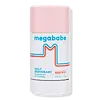What's inside
What's inside
 Key Ingredients
Key Ingredients

 Benefits
Benefits

 Concerns
Concerns

 Ingredients Side-by-side
Ingredients Side-by-side

Propylene Glycol
HumectantWater
Skin ConditioningSodium Stearate
CleansingSaccharomyces Ferment
Skin ConditioningPropanediol
SolventZea Mays Starch
AbsorbentParfum
MaskingHydrated Silica
AbrasiveRosa Damascena Flower Oil
MaskingSqualane
EmollientSalix Alba Bark Extract
AstringentCaffeine
Skin ConditioningArginine
MaskingAvena Sativa Kernel Flour
AbrasiveGlycerin
HumectantCamellia Sinensis Leaf Extract
AntimicrobialAloe Barbadensis Leaf Juice
Skin ConditioningSalvia Officinalis Leaf Extract
CleansingLeuconostoc/Radish Root Ferment Filtrate
AntimicrobialCocos Nucifera Oil
MaskingSilica Cetyl Silylate
Ethylhexylglycerin
Skin ConditioningHydrogenated Olive Oil Unsaponifiables
EmollientPhenoxyethanol
PreservativeSodium Benzoate
MaskingPotassium Sorbate
PreservativePropylene Glycol, Water, Sodium Stearate, Saccharomyces Ferment, Propanediol, Zea Mays Starch, Parfum, Hydrated Silica, Rosa Damascena Flower Oil, Squalane, Salix Alba Bark Extract, Caffeine, Arginine, Avena Sativa Kernel Flour, Glycerin, Camellia Sinensis Leaf Extract, Aloe Barbadensis Leaf Juice, Salvia Officinalis Leaf Extract, Leuconostoc/Radish Root Ferment Filtrate, Cocos Nucifera Oil, Silica Cetyl Silylate, Ethylhexylglycerin, Hydrogenated Olive Oil Unsaponifiables, Phenoxyethanol, Sodium Benzoate, Potassium Sorbate
Glycerin
HumectantWater
Skin ConditioningMaranta Arundinacea Root Powder
Skin ConditioningPropanediol
SolventSodium Stearate
CleansingHydrated Silica
AbrasiveSaccharomyces Ferment Filtrate
HumectantAloe Barbadensis Leaf Juice
Skin ConditioningMaltodextrin
AbsorbentAllantoin
Skin ConditioningSalicylic Acid
MaskingSorbic Acid
PreservativeCharcoal
AbrasiveMagnesium Hydroxide
AbsorbentBenzyl Alcohol
PerfumingPotassium Sorbate
PreservativeSodium Benzoate
MaskingCitrus Sinensis Peel Oil Expressed
PerfumingCitrus Aurantium Bergamia Fruit Oil
MaskingCitrus Grandis Peel Oil
MaskingGlycerin, Water, Maranta Arundinacea Root Powder, Propanediol, Sodium Stearate, Hydrated Silica, Saccharomyces Ferment Filtrate, Aloe Barbadensis Leaf Juice, Maltodextrin, Allantoin, Salicylic Acid, Sorbic Acid, Charcoal, Magnesium Hydroxide, Benzyl Alcohol, Potassium Sorbate, Sodium Benzoate, Citrus Sinensis Peel Oil Expressed, Citrus Aurantium Bergamia Fruit Oil, Citrus Grandis Peel Oil
 Reviews
Reviews

Ingredients Explained
These ingredients are found in both products.
Ingredients higher up in an ingredient list are typically present in a larger amount.
Aloe Barbadensis Leaf Juice comes from leaves of the aloe plant. Aloe Barbadensis Leaf Juice is best known for helping to soothe sunburns. It is also anti-inflammatory, moisturizing, antiseptic, and can help heal wounds.
Aloe is packed with good stuff including Vitamins A, C, and E. These vitamins are antioxidants, which help fight free-radicals and the damage they may cause. Free-radicals are molecules that may damage your skin cells, such as pollution.
Aloe Barbadensis Leaf Juice also contains sugars. These sugars come in the form of monosaccharides and polysaccharides, folic acid, and choline. These sugars are able to help bind moisture to skin.
It also contains minerals such as calcium, 12 anthraquinones, fatty acids, amino acids, and Vitamin B12.
Learn more about Aloe Barbadensis Leaf JuiceGlycerin is already naturally found in your skin. It helps moisturize and protect your skin.
A study from 2016 found glycerin to be more effective as a humectant than AHAs and hyaluronic acid.
As a humectant, it helps the skin stay hydrated by pulling moisture to your skin. The low molecular weight of glycerin allows it to pull moisture into the deeper layers of your skin.
Hydrated skin improves your skin barrier; Your skin barrier helps protect against irritants and bacteria.
Glycerin has also been found to have antimicrobial and antiviral properties. Due to these properties, glycerin is often used in wound and burn treatments.
In cosmetics, glycerin is usually derived from plants such as soybean or palm. However, it can also be sourced from animals, such as tallow or animal fat.
This ingredient is organic, colorless, odorless, and non-toxic.
Glycerin is the name for this ingredient in American English. British English uses Glycerol/Glycerine.
Learn more about GlycerinHydrated Silica is a type of silicon dioxide. It is called 'hydrated silica' because it is silica with extra bonded water atoms.
It is an absorbent and abrasive, meaning it is exfoliating.
Silica is often used for absorption and can help reduce shine when products are applied.
Learn more about Hydrated SilicaPotassium Sorbate is a preservative used to prevent yeast and mold in products. It is commonly found in both cosmetic and food products.
This ingredient comes from potassium salt derived from sorbic acid. Sorbic acid is a natural antibiotic and effective against fungus.
Both potassium sorbate and sorbic acid can be found in baked goods, cheeses, dried meats, dried fruit, ice cream, pickles, wine, yogurt, and more.
You'll often find this ingredient used with other preservatives.
Learn more about Potassium SorbatePropanediol is an all-star ingredient. It softens, hydrates, and smooths the skin.
It’s often used to:
Propanediol is not likely to cause sensitivity and considered safe to use. It is derived from corn or petroleum with a clear color and no scent.
Learn more about PropanediolSodium Benzoate is a preservative. It's used in both cosmetic and food products to inhibit the growth of mold and bacteria. It is typically produced synthetically.
Both the US FDA and EU Health Committee have approved the use of sodium benzoate. In the US, levels of 0.1% (of the total product) are allowed.
Sodium benzoate works as a preservative by inhibiting the growth of bacteria inside of cells. It prevents the cell from fermenting a type of sugar using an enzyme called phosphofructokinase.
It is the salt of benzoic acid. Foods containing sodium benzoate include soda, salad dressings, condiments, fruit juices, wines, and snack foods.
Studies for using ascorbic acid and sodium benzoate in cosmetics are lacking, especially in skincare routines with multiple steps.
We always recommend speaking with a professional, such as a dermatologist, if you have any concerns.
Learn more about Sodium BenzoateSodium stearate is the sodium salt of stearic acid.
The structure of sodium stearate makes it both a cleanser and emulsifier. As a cleanser, it helps dissolve dirt, oil, and other pollutants. As an emulsifier, it helps prevent ingredients from separating. This adds stability to the formula.
Water. It's the most common cosmetic ingredient of all. You'll usually see it at the top of ingredient lists, meaning that it makes up the largest part of the product.
So why is it so popular? Water most often acts as a solvent - this means that it helps dissolve other ingredients into the formulation.
You'll also recognize water as that liquid we all need to stay alive. If you see this, drink a glass of water. Stay hydrated!
Learn more about Water